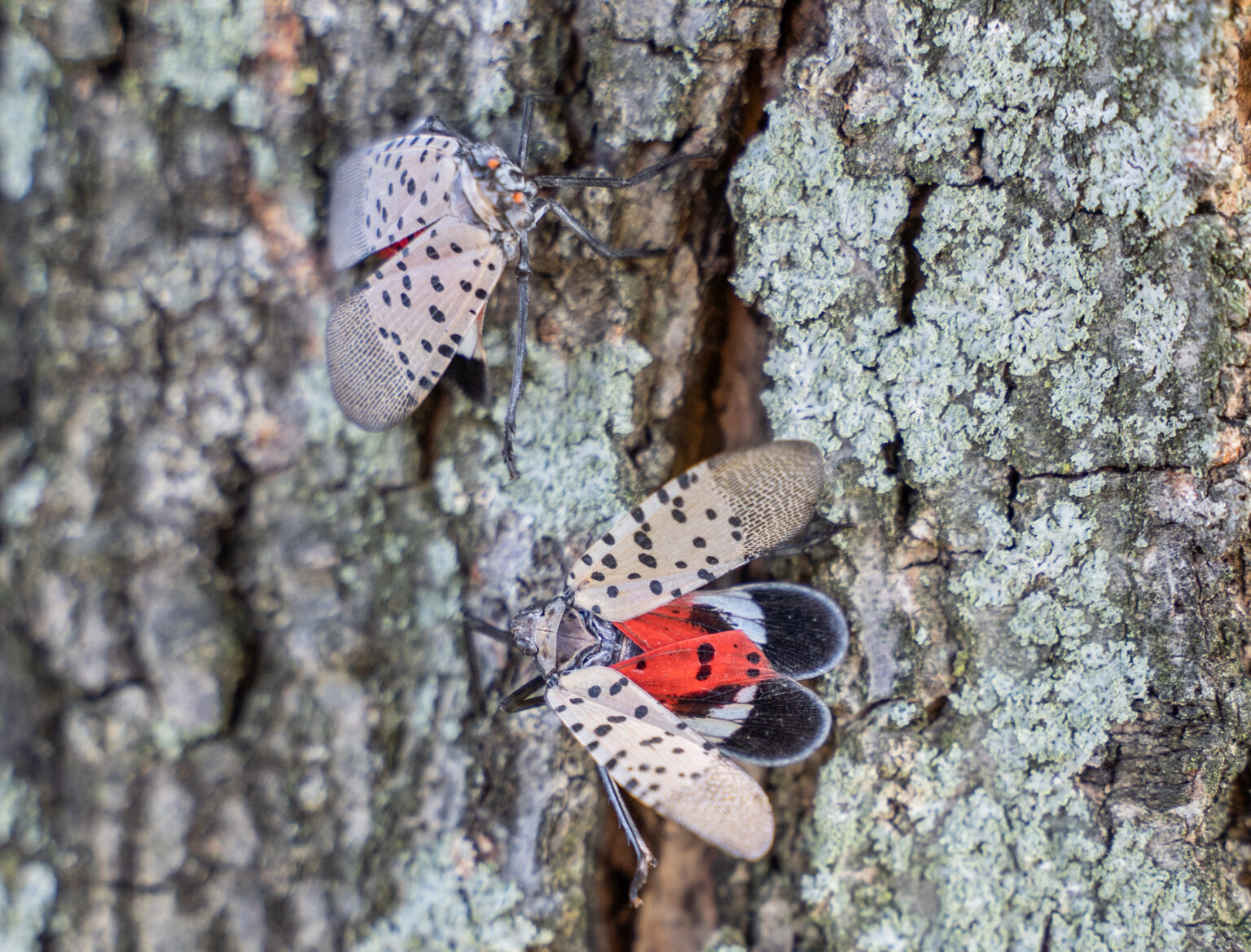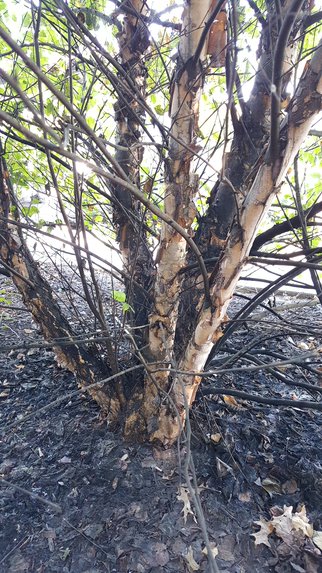In the vast and diverse landscape of the United States, a silent invader is making its mark, and it’s not going unnoticed. Meet the Spotted Lanternfly (Lycorma delicatula), an emerging pest with a voracious appetite and a penchant for destructive behavior. This article delves into the intricate relationship between this invasive insect and its preferred host, the Tree-of-heaven, also known as the Ailanthus altissima. We also dive into the other trees affected by this invasive bug, along with how to identify it, how to destroy their eggs, and we also talk about the different type of damage that can occur from them.
The Spotted Spectacle
Originating from Asia, the Spotted Lanternfly was first recognized in the U.S. a few years ago and has since been a growing concern for agriculturalists and environmentalists alike. Its decorative appearance—grey forewings dotted with dark spots and a visually striking red hindwing—belies its harmful nature. Click here to see Spotted Lanternfly reported distribution provided by the New York State Integrated Pest Management Program.
One might wonder, why the concern? The lanternfly is not a discerning diner. While it showcases a particular fondness for the Tree-of-heaven, it doesn’t shy away from feasting on a variety of important agricultural crops. Grapes, fruit trees, hops, and ornamentals are all on its menu, leading to significant agricultural losses.

What Do Spotted Lantern Fly Eggs Look Like
Furthermore, their reproductive cycle is alarmingly efficient. Adult lanternflies, which emerge around July, lay their grey-brown eggs on tree barks and other outdoor surfaces from September to April. These eggs then hatch between April and May, releasing nymphs that go through four distinct developmental stages, each more harmful than the last.
But what makes the Spotted Lanternfly’s invasion even more alarming is its rapid spread. Currently rooted in several northeastern states, there’s a tangible threat of them blanketing North America, thanks to our modern transportation systems. Whether by car, rail, or air, these pests have found ways to hitch rides and expand their territories.
The Tree-of-heaven: An Unwitting Accomplice
The Tree-of-heaven (Ailanthus altissima), native to China and Taiwan, is another foreign entrant to the U.S. landscape. Towering up to 65 feet, this tree is not only fast-growing but also highly resilient. Its smooth gray bark and uniquely scented leaves have made it recognizable among botanists and environmentalists.
However, its resilience is a double-edged sword. With the capacity to reproduce both through seeds and vegetatively, a single mature female tree can produce a staggering 325,000 seeds annually. As a result, this tree has found comfort across various habitats—forest edges, roadsides, riverbanks, and urban regions. Eastern Washington, in particular, has seen a high distribution of this tree.
While the Tree-of-heaven in itself can be problematic—crowding out native vegetation, releasing growth-inhibiting chemicals, and even causing allergic reactions in some humans—it’s its role as the primary host for the Spotted Lanternfly that elevates its threat level.
Trees and Bushes Affected By The Spotted Lanternfly
These are the trees and bushes affected by the spotted lanternfly…
Tree/Bush | Danger | Damage Identification |
Ailanthus altissima – Tree of Heaven | High | Egg masses on trunks, look for egg masses resembling grayish-brown splotches on tree trunks, branches, and other surfaces. oozing wounds, sticky residue |
Mulberry Tree | Moderate | Wilting, sap weeping, honeydew secretion on leaves, branches, and the ground underneath, often leading to the growth of sooty mold. |
Apple Tree | Moderate to High | Presence of sap oozing from the tree’s trunk or branches, often attracting other insects and leading to sooty mold growth, sooty mold, fruit damage, egg masses |
Cherry Tree | Moderate | Sap oozing, sooty mold, leaves and branches wilting, yellowing, or dying prematurely. |
Peach Tree | Moderate | Sap oozing, wilting, honeydew secretion, Infested fruits may show signs of scarring, discoloration, or deformation. |
Plum | Low to Moderate | Sap oozing, sooty mold, wilting |
Maple Tree | Low to Moderate | Sap oozing, honeydew secretion |
Oak Tree | Low | Sap oozing, wilting, sooty mold |
Low | Sap oozing, wilting, sooty mold | |
Blueberry Bush | Moderate | Wilting, sap weeping, honeydew secretion, sooty mold |

Spotted Lanternfly Tree Damage
The Spotted Lanternfly (Lycorma delicatula) presents a complex array of detrimental impacts on our cherished trees, plants, and valuable crops due to its distinct feeding behavior and the secretion of honeydew. At the core of its effects lies its remarkable ability to tap into the sap of our arboreal companions. With specialized mouthparts, the insect pierces bark to access the sap coursing through the intricate vascular system of the host tree. This relentless sap extraction compromises the tree’s capacity to transport vital water, nutrients, and sugars. As a result, we observe an unsettling pattern of weakened trees that struggle with wilting, yellowing, and eventual loss of leaves and branches. This diminished state of the tree renders it vulnerable to various environmental stressors, diseases, and pest pressures that can be especially disheartening for arborists and tree enthusiasts.
Adding to this challenge, the Spotted Lanternfly secretes honeydew, a sticky substance, as a byproduct of its sap-feeding activities. This honeydew settles on leaves, branches, and the ground below, creating an ideal breeding ground for sooty mold—a black fungal growth that impedes the tree’s capacity for photosynthesis and overall vigor. The repercussions extend beyond this as weakened trees and the presence of honeydew and sooty mold attract a parade of unwelcome visitors. Notably, ants and wasps are lured by the sugary honeydew, further unsettling the tree’s ecosystem and balance. This cascade of events can lead to an increased susceptibility to diseases and other pest infestations, underscoring the complexity of the situation.
Adding to our concerns, the Spotted Lanternfly doesn’t shy away from targeting fruit-bearing trees. Its feeding activities can result in marred fruits—blemishes, discoloration, and deformities—that cast a shadow on the trees’ economic and aesthetic value. Indeed, this is a pressing matter, particularly for our agricultural landscapes, where the livelihoods of many are entwined with these trees.
As arborists, we witness the cumulative effects of these damages firsthand, witnessing the once-grand trees succumb to decline and ultimately perish. These outcomes ripple through ecosystems, agricultural production, and our visual tapestry. Meeting this challenge head-on requires us to employ a multi-pronged approach: to manage their population, shield our trees and crops, and halt their relentless expansion to new territories. In the face of the Spotted Lanternfly threat, our roles as stewards of nature and defenders of trees have never been more critical.
How To Destroy Spotted Lanternfly Eggs
- Identification of Egg Masses:
- Spotted lanternfly egg masses are usually rectangular and start as cream-colored, darkening into gray or light brown.
- They are laid in clusters of 30 to 50 eggs and are coated with a protective layer to survive the winter.
- Location of Egg Masses:
- Lanternflies lay their eggs on various surfaces, including trees of heaven, fruit trees, rocks, walls, vehicles, and furniture.
- Egg masses are typically found on flat, smooth, vertically oriented surfaces.
- Timing and Action:
- Destroy egg masses during the fall, winter, and early spring before hatching in May.
- Take action to prevent the next generation of lanternflies.
- Methods to Destroy Egg Masses:
- Use a flat-edged tool like a knife or ruler to safely scrape egg masses off surfaces.
- Collect the egg masses and dispose of them in the trash.
- Optional Safety Precautions:
- If desired, eggs can be submerged in water or alcohol before disposal.
- Non-Chemical Approach Preferred:
- Experts suggest prioritizing non-chemical methods to control lanternflies.
- Scrape and remove egg masses to reduce the population without ecological harm.
- Trap Trees as a Solution:
- Planting a “trap tree,” often a tree of heaven, and injecting it with insecticides can attract and kill lanternflies.
- This method might be more suitable for farmers or those willing to undertake a larger project.
- Natural Predators and Parasites:
- Scientists are actively researching and seeking natural predators or parasites that can help control lanternfly populations.
- The hope is that these predators will emerge and exert “natural biological control” over lanternflies.
What Eats Spotted Lanternfly
The lanternfly lacks many natural predators that have evolved to keep its population in check. This absence of significant natural predators has contributed to its rapid proliferation, and the problem states like New York and New Jersey are dealing with regarding their expansion and tree damage.
- Praying Mantis:
- Praying mantises are significant predators of spotted lanternflies.
- They blend in with vegetation and ambush lanternflies.
- Sharp front legs grab and immobilize the lanternfly before consumption.
- Chickens:
- Chickens, known for consuming various insects, include lanternflies in their diet.
- They peck at lanternflies on the ground or plants and can swallow both adults and nymphs.
- Garden Spiders:
- Garden spiders inhabit the same habitat as lanternflies.
- They capture lanternflies in their intricate webs and inject venom to immobilize them.
- The spider may consume the lanternfly immediately or wrap it in silk for later consumption.
- Gray Catbirds:
- Gray catbirds, birds living in meadows and thickets, eat both insects and berries.
- They can consume adult lanternflies or groups of nymphs.
- Yellow Jackets:
- Yellow jackets are attracted to nectar and sap and eat a variety of insects.
- They sting lanternflies to immobilize them, then use mandibles to consume them.
- Wheel Bugs:
- Wheel bugs are large insects that eat caterpillars, beetles, and other insects.
- They capture lanternflies using their powerful front legs and consume them.
- Garter Snakes:
- Garter snakes consume small rodents, fish, and insects.
- They capture and swallow adult lanternflies or nymphs in their habitats.
- Koi Fish:
- Koi fish, colorful and related to carp, also eat insects.
- They consume lanternflies that accidentally fall into ponds.
Spotted Lantern Fly Control – Call Us For a Free Estimate
For those seeking a steadfast ally in the battle against the challenges posed by invasive species like the Spotted Lanternfly and the Tree-of-heaven, look no further than Owens Brothers Tree Service. With an illustrious legacy spanning over six decades, we bring forth a wealth of experience and expertise, uniquely poised to address these pests and the havoc they unleash. We service the Bronx and Manhattan primarily.
Our arborists boast a deep-rooted understanding of the intricate dynamics at play, having confronted these issues head-on for numerous years. We navigate the terrain of invasive species, rendering their impact manageable and paving the way for the flourishing of your cherished trees and vegetation.
Give us a call for a free consultation 718-885-0914